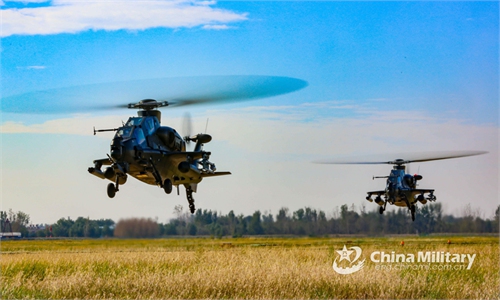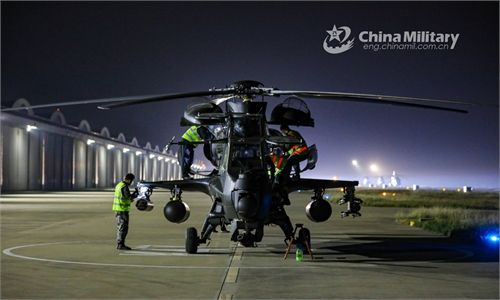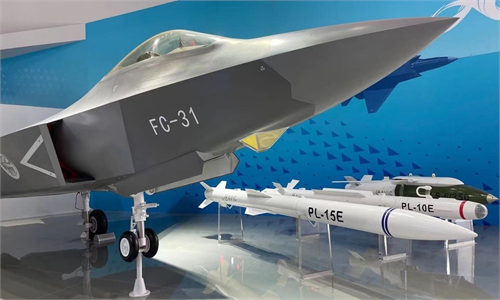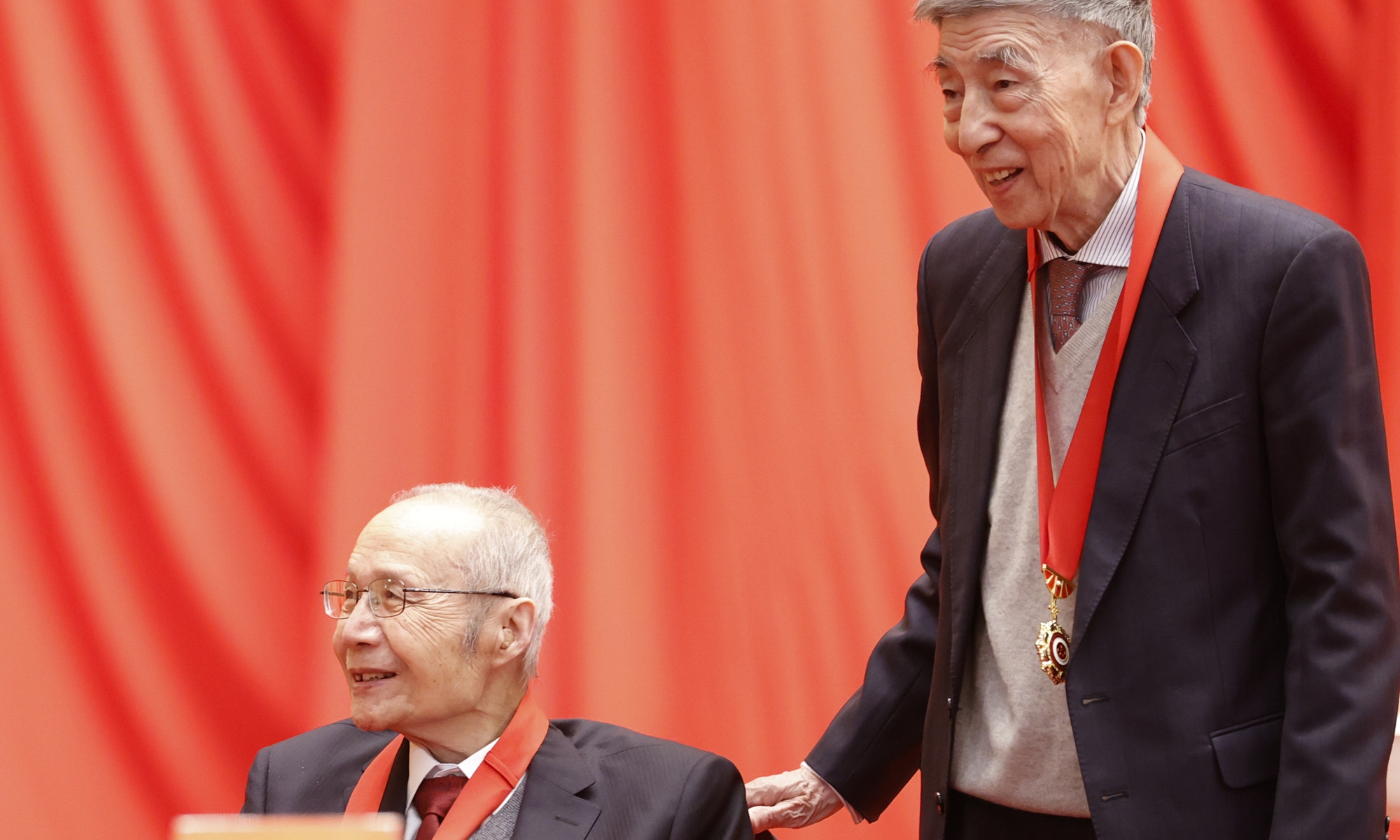
China's top science award is conferred onto aircraft designer Gu Songfen (left) and nuclear expert Wang Dazhong for their outstanding contributions to scientific and technological innovation on November 3, 20201. Photo: cnsphoto
Two Chinese scientists, fighter jet designer Gu Songfen and nuclear energy scientist Wang Dazhong, won China's top science award Wednesday for their outstanding contributions to scientific and technological innovation.
Experts and observers said the award shows China values the work of Gu and Wang, encourages scientists and researchers to embrace their spirit, and indicates that the country will continue to make strides in military aircraft and nuclear energy.
President Xi Jinping on Wednesday presented the country's top science award to the two scientists at an annual ceremony held in Beijing to honor distinguished scientists, engineers and research achievements, the Xinhua News Agency reported on Wednesday.
Gu, 91, was born in February 1930 in East China's Jiangsu Province. He is a research fellow at the Aviation Industry Corporation of China (AVIC), and an academician of the Chinese Academy of Sciences (CAS) and the Chinese Academy of Engineering (CAE).
As a master in aircraft design and the founder of aerodynamic design of the People's Republic of China, Gu has always been committed to promoting the development of China's aviation technology, as he helped develop key aviation technologies, and established the country's aircraft design system.
The aircraft he developed made history, allowing China to have fighters, and he guided and promoted the construction of the country's aviation industry, trained academicians, experts and leading talent, and greatly supported the development of the country's aviation weapons.
Having made up his mind to build warplanes when he was a child after he survived Japanese bombings in the War of Resistance Against Japanese Aggression (1931-45), Gu was in charge of the aerodynamic design of China's first jet, the JJ-1, China's first basic trainer, the CJ-6, China's first supersonic fighter jet, the J-8, and China's first fighter jet capable of beyond-visual-range combat, the J-8II, laying the cornerstone for China's subsonic and supersonic aerodynamic design. He promoted the development of the country's aerodynamic research and design infrastructure.

Fighter jet designer Gu Songfen and nuclear energy scientist Wang Dazhong on Wednesday received China's top science and technology award of 2020 for their outstanding contributions to scientific and technological innovation.Graphic:Deng Zijun/GT
Among Gu's creations, the CJ-6 and the J-8 series aircraft have had a particular impact on the Chinese military, observers said.
Still in active service even after six decades, the CJ-6 basic trainer aircraft has an outstanding flight performance, and has trained tens of thousands of pilots for the Chinese military.
Considered by the Chinese military at that time as "the most high-end fighter jet of the country's air force that will help to improve air force equipment and enhance national defense," the J-8II, and its predecessor the J-8 were the Chinese military's main aircraft in the late 20th century, with more than 350 J-8 series aircraft entering service.
During J-8 test flights, Gu insisted on flying as a co-pilot on a JJ-6 fighter trainer despite the risks, so he could observe the J-8's performance up front, and eventually solve its problems.
He also put forward a number of proposals for large aircraft projects and the national aviation emergency rescue system, and in terms of the development of the aviation weapon system, he made recommendations for the development of new-generation fighter jets and helicopters.
The Chinese military now operates advanced, domestically developed aircraft like the J-10 fighter jet, Y-20 large transport aircraft, JL-9 trainer jet and J-15 aircraft carrier-based fighter jet, and they reflect Gu's contributions, the Global Times learned from AVIC on Tuesday.
Gu also proposed the development of military artificial intelligence and other technologies.
At a time when artificial intelligence technology is fast developing, military aircraft are expected to be equipped with such technology, particularly the next-generation fighter jet, to assist in pilot decisions, observers said.
Many development proposals raised by Gu, including those on the strategy to build amajor aviation power, have been adopted and put into practice, and have contributed significantly to the 70-year development of new China's aviation industry.
Gu is among the first generation of designers in China who were devoted to the independent development of aircraft, and made outstanding contributions to the development of China's fighters and large aircraft, Fu Qianshao, a Chinese military aviation expert, told the Global Times on Wednesday.
"It is the efforts and sacrifice of the older generation that have built China's aviation industry. Gu deserves the award," Fu said.
Wang, 86, was born in 1935 in North China's Hebei Province. He is a professor and former president of Tsinghua University.
Also a CAS academician, Wang is an internationally recognized scientist and educator on nuclear engineering and nuclear safety.
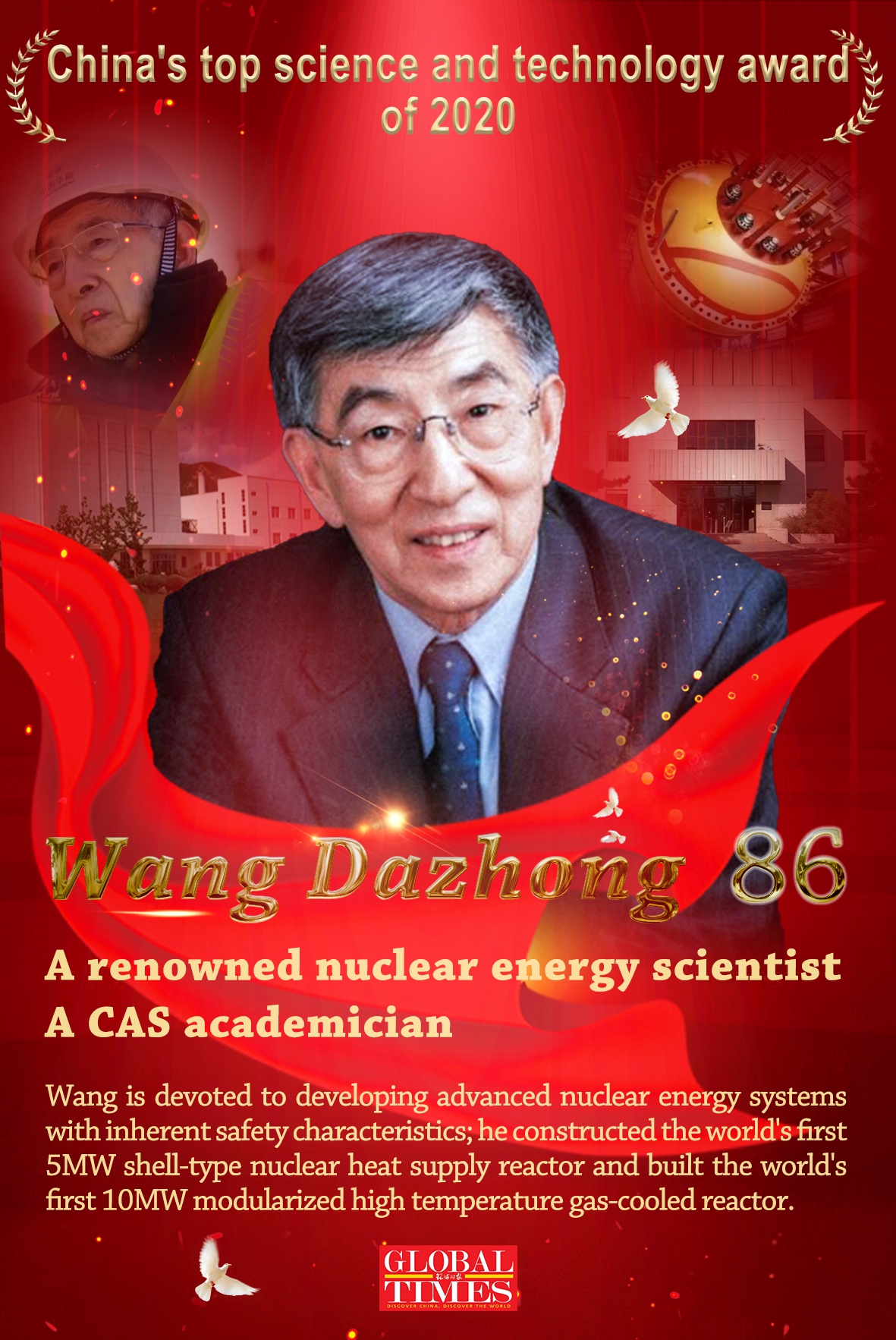
Fighter jet designer Gu Songfen and nuclear energy scientist Wang Dazhong on Wednesday received China's top science and technology award of 2020 for their outstanding contributions to scientific and technological innovation.Graphic:Deng Zijun/GT
In the 1960s, Wang led the design and construction of a shielded test reactor built by China. He later directed the research and development of high temperature, gas-cooled reactors and created a new concept of modular-type high temperature, gas-cooled reactors.
In the 1980s, he created a new field of nuclear energy heat supply research and supervised the research, design, and construction of the world's first 5MW shell-type nuclear heat supply reactor.
He also created the world's first 10MW modular high temperature, gas-cooled reactor.
High temperature gas-cooled reactors, globally known as the fourth-generation nuclear energy system, are believed to have broad development prospects for their inherent safety, versatility and modular construction. They require no water for cooling, and their melting point exceeds the upper limit of the reactor's temperature range.
After the 1986 disaster at the Chernobyl nuclear power plant in Ukraine, Wang said modular-type high temperature, gas-cooled reactors with high safety will be a major trend in nuclear industry development. He and his team continued to conduct research on the development of 10MW high temperature, gas-cooled reactors (HTR-10).
The world's first industrial-scale demonstration plant of such a reactor with a pebble-bed module is being built in Shidaowan, East China's Shandong Province. It completed fuel loading on August 21, bringing it a step closer to grid-connected power generation within the year.
Wang's research led him to acquire patents in Germany, the US and Japan, as he led research teams to surpass the world's advanced nuclear energy technologies.
Wang's work contributed to China's leading status in nuclear energy exploration, and ensures that China blazes a trail in a world where major nuclear powers have largely given up pursuing nuclear energy, Lin Boqiang, director of the China Center for Energy Economics Research at Xiamen University, told the Global Times on Wednesday.
Wang's work on small-sized reactors is cutting-edge technology and has great potential once the issue on cost and safety is addressed, Lin said.
Awarding Wang also reflects China's ambition to continue its pursuit of nuclear energy, Lin said.
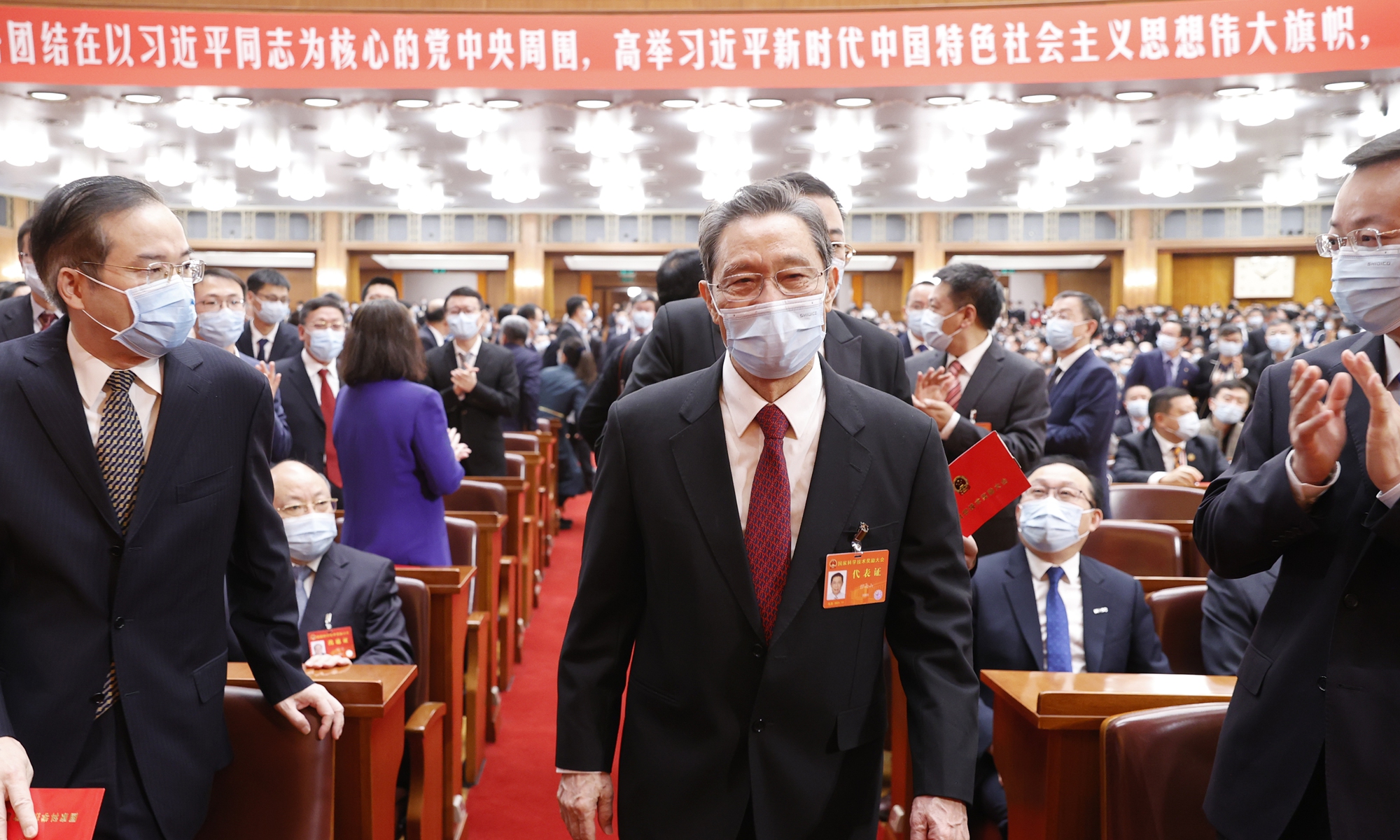
An annual ceremony is held in Beijing to honor distinguished scientists, engineers and research achievements on November 3, 2021. A team led by China's top epidemiologist Zhong Nanshan was awarded the State Scientific and Technological Progress Award, for its contribution to the prevention, diagnosis and treatment of major respiratory diseases. Photo: cnsphoto
Encouraging spirit
Gu and Wang will each receive a prize of 8 million yuan ($1.25 million), China Youth Daily reported on Wednesday.
The prize money was originally set at 5 million yuan, with 500,000 yuan for their personal use and 4.5 million yuan to fund the recipient's scientific research. But since 2018, the prize money was raised to 8 million yuan, which the recipient can freely use.
This shows that China attaches importance to scientific and technological development, and encourages scientists and researchers to embrace the "Two Bombs and One Satellite" spirit, a valuable spiritual asset for the Chinese people featuring patriotism, dedication, and lasting self-reliance, hard work, cooperation and courage in overcoming difficulties and obstacles, especially in the scientific and technological fields. It's also a prelude to greater strides as the country enters its 14th Five-Year Plan period (2021-25), analysts said.
In 2019, the award went to nuclear submarine designer Huang Xuhua and meteorologist Zeng Qingcun, while in 2018, radar expert Liu Yongtan and defense engineering expert Qian Qihu received the award.
The award shows the importance of national defense to the country, observers said.
Awards were also given to medical breakthroughs including research on the immunogenetic mechanisms of leprosy, technologies for the early accurate diagnosis of lung cancer, and the industrialization of self-developed high-field magnetic resonance medical-imaging equipment.
A respiratory disease prevention and control team led by China's top epidemiologist Zhong Nanshan was awarded the State Scientific and Technological Progress Award, for its contribution to the prevention, diagnosis and treatment of major respiratory diseases, such as lung cancer, SARS and COVID-19.


